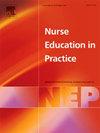Three debriefing methods in virtual patient simulation: A randomized controlled trial
IF 3.3
3区 医学
Q1 NURSING
引用次数: 0
Abstract
Background
Debriefing is essential after virtual patient simulations; however, optimal approaches remain limited.
Aim
To evaluate three different debriefing methods used with nursing students following virtual patient simulations, focusing on debriefing experience, simulation effectiveness, satisfaction and self-confidence.
Design
A blinded, randomized controlled, parallel group with pre- and post-test trial.
Methods
109 nursing students in their final-year were randomly assigned to three groups by an independent educator: Group A (n = 36), applied the Diamond, Group B (n = 36) applied Debriefing with Meaningful Learning (DML) and the Control Group (n = 37) applied Self-debriefing methods. Participants and the data analyst were blinded. The “Demographic Questionnaire”, “Debriefing Experience Scale (DES)”, “Simulation Effectiveness Tool-Modified (SET-M)”, “Student Satisfaction and Self-confidence in Learning Scale (SCLS)” were used to obtain data.
Results
Baseline measurements were similar between all groups. The DES showed differences within groups (p < 0.05, d> 0.8) and between groups across all subscales and total scores (p < 0.05). In the SET-M, within-group comparisons revealed significant differences in all groups. In contrast, an important difference was only revealed in the debriefing subscale between groups (p < 0.05). The largest effects in “debriefing” were between Group A versus Control and Group B versus Control (d>0.8). The SCLS revealed significant differences in all groups in within-group comparisons (p < 0.05).
Conclusions
The results indicate that all debriefing methods are effective regarding DES, SET-M and SCLS scores. DML method yielded the highest gains. Findings offer evidence-based guidance for selecting debriefing strategies to enhance engagement and learning in virtual patient simulations.
虚拟病人模拟中的三种汇报方法:一项随机对照试验
在虚拟病人模拟后,汇报是必不可少的;然而,最佳方法仍然有限。目的评价护生在虚拟病人模拟后所采用的三种不同的述职方法,主要从述职体验、模拟效果、满意度和自信心等方面进行评价。设计盲法、随机对照、平行组,进行试验前和试验后试验。方法将109名护生随机分为3组:A组(n = 36)采用Diamond法,B组(n = 36)采用有意义学习法(DML),对照组(n = 37)采用自我汇报法。参与者和数据分析师是盲的。采用“人口统计问卷”、“汇报经验量表(DES)”、“模拟效能工具修正量表(SET-M)”、“学生学习满意度与自信心量表(SCLS)”进行数据获取。结果各组间基线测量值相似。DES组间差异有统计学意义(p <; 0.05,d>;0.8),所有子量表和总分的组间差异(p <; 0.05)。在SET-M中,组内比较显示各组之间存在显著差异。相比之下,两组之间的重要差异仅体现在汇报子量表上(p <; 0.05)。在“汇报”方面,A组与对照组、B组与对照组的影响最大(d>0.8)。各组scs组内比较差异有统计学意义(p <; 0.05)。结论两种方法对DES、SET-M和scs评分均有较好的影响。DML方法的收益最高。研究结果为选择汇报策略提供了循证指导,以提高虚拟患者模拟中的参与度和学习。
本文章由计算机程序翻译,如有差异,请以英文原文为准。
求助全文
约1分钟内获得全文
求助全文
来源期刊

Nurse Education in Practice
NURSING-
CiteScore
5.40
自引率
9.40%
发文量
180
审稿时长
51 days
期刊介绍:
Nurse Education in Practice enables lecturers and practitioners to both share and disseminate evidence that demonstrates the actual practice of education as it is experienced in the realities of their respective work environments. It is supportive of new authors and will be at the forefront in publishing individual and collaborative papers that demonstrate the link between education and practice.
 求助内容:
求助内容: 应助结果提醒方式:
应助结果提醒方式:


